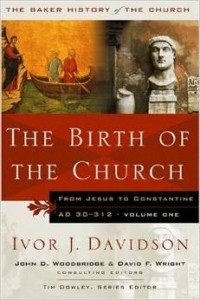Ivor J. Davidson:
The story of the Christian church has its genesis in the belief of a small group of Jews in the first-century Palestine that a man who had been crucified had been raised from the dead. Jesus of Nazareth, the charismatic prophet, teacher, and healer whose ministry had caused a storm in Galilee and Judea, appeared to have died in defeat and he had been put to death by crucifixion, sentenced by the Roman prefect of Judea, Pontius Pilate, around the year A.D. 30.
This ought to have been the end of the matter. Jesus, it seemed, was just another failed reformer–courageous, no doubt, in his protest against religious and moral systems that he felt were wrong; commendable, certainly, in his principled concern for the needs and the marginalized and his practical efforts to address social injustices; but in the end just another pious martyr to a cause.
Jesus had been an impressive teacher and miracle worker; and his brief ministry had made an impact on a wide variety of people, but he had died a common criminal’s death, crying out to God in an apparent sense of being forsaken. His death left his band of followers without a leader and without any obvious sense of direction.
Whatever Jesus had stood for; it appeared either that he had been mistaken or that his mission was a failure.
What changed all this was the conviction that though Jesus had died a violent death and been laid in a tomb, he was dead no longer. Within a matter of days of his crucifixion, stories were circulating that his grave was empty and that he had been raised from the dead.
The belief that Jesus was raised was not some pious idea that the events of his crucifixion had been reversed or that the dreadful reality of his suffering had somehow been cancelled out. The Jesus who appeared was not a resuscitated corpse, amazingly brought to life again. Nor was he a ghost or a phantom pictured in the minds of grieving–and perhaps guilt-ridden–disciples, looking back sentimentally on the individual they had known and failed in the hour of his greatest need.
At the heart of the first-believers’ faith was a conviction that Jesus was alive as a concrete, flesh-and-blood reality.
His followers believed his appearances were confirmations that God had vindicated him and that his life and death, far from being in vain, were in fact the decisive means by which God was acting in history to effect not only the renewal of Israel but the redemption of the world.
-Ivor J. Davidson, The Birth of The Church: From Jesus to Constantine AD 30-312 (Grand Rapids: Baker Books, 2004), 11-12.

Be First to Comment